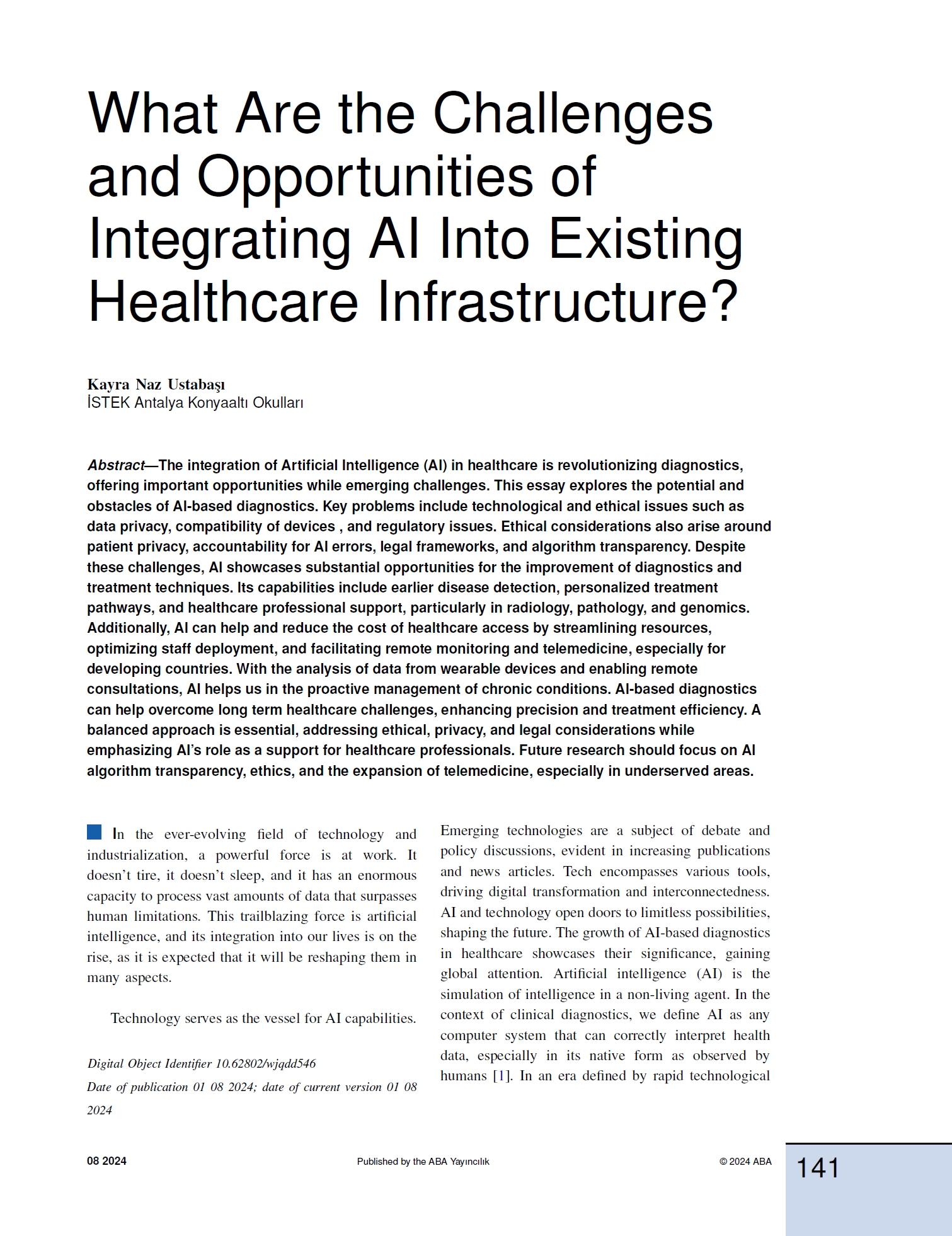What Are the Challenges and Opportunities of Integrating AI Into Existing Healthcare Infrastructure?
DOI:
https://doi.org/10.62802/dvmbnm16Keywords:
Artificial Intelligence in Healthcare, AI-based diagnostics, AI, treatment efficiency, integration, ethicsAbstract
The integration of Artificial Intelligence (AI) in healthcare is revolutionizing diagnostics, offering important opportunities while emerging challenges. This essay explores the potential and obstacles of AI-based diagnostics. Key problems include technological and ethical issues such as data privacy, compatibility of devices , and regulatory issues. Ethical considerations also arise around patient privacy, accountability for AI errors, legal frameworks, and algorithm transparency. Despite these challenges, AI showcases substantial opportunities for the improvement of diagnostics and treatment techniques. Its capabilities include earlier disease detection, personalized treatment pathways, and healthcare professional support, particularly in radiology, pathology, and genomics. Additionally, AI can help and reduce the cost of healthcare access by streamlining resources, optimizing staff deployment, and facilitating remote monitoring and telemedicine, especially for developing countries. With the analysis of data from wearable devices and enabling remote consultations, AI helps us in the proactive management of chronic conditions. AI-based diagnostics can help overcome long term healthcare challenges, enhancing precision and treatment efficiency. A balanced approach is essential, addressing ethical, privacy, and legal considerations while emphasizing AI’s role as a support for healthcare professionals. Future research should focus on AI algorithm transparency, ethics, and the expansion of telemedicine, especially in underserved areas.References
Dias, R., Torkamani, A. Artificial intelligence in clinical and genomic diagnostics.Genome Med 11, 70 (2019).
V. Rajaraman, “John McCarthy—father of artificial intelligence,” Resonance, vol. 19, no. 3, pp. 198–207, 2014.
M. Brickley, J. Shepherd, and R. Armstrong, “Neural networks: a new technique for development of decision support systems in dentistry,” Journal of Dentistry, vol. 26, no. 4, pp. 305–309, 1998.
M. Tripathy, R. P. Maheshwari, and H. Verma, “Power transformer differential protection based on optimal probabilistic neural network,” IEEE transactions on Power Delivery, vol. 25, no. 1, pp. 102–112, 2010.
N. Boreak, “Effectiveness of artificial intelligence applications designed for endodontic diagnosis, decision-making, and prediction of prognosis: a systematic review,” The Journal of Contemporary Dental Practice, vol. 21, no. 8, pp. 926–934, 2020.
Daniele Rotolo, Diana Hicks, Ben R. Martin, What is an emerging technology?, Research Policy, Volume 44, Issue 10, (2015)
Park CJ Yi PH, Siegel EL. Medical student perspectives on the impact of artificial intelligence on the practice of medicine. Curr Probl Diagn Radiol. (2020) 50:614–9. doi: 10.1067/j.cpradiol.2020.06.01
Sit C, Srinivasan R, Amlani A, Muthuswamy K, Azam A, Monzon L, et al. Attitudes and perceptions of UK medical students towards artificial intelligence and radiology: a multicentre survey. Insights Imaging. (2020) 11:14. doi: 10.1186/s13244-019-0830-7
https://www.upguard.com/blog/biggest-data-breaches-in-healthcare
https://gdpr-info.eu/issues/consent/. (n.d.).









